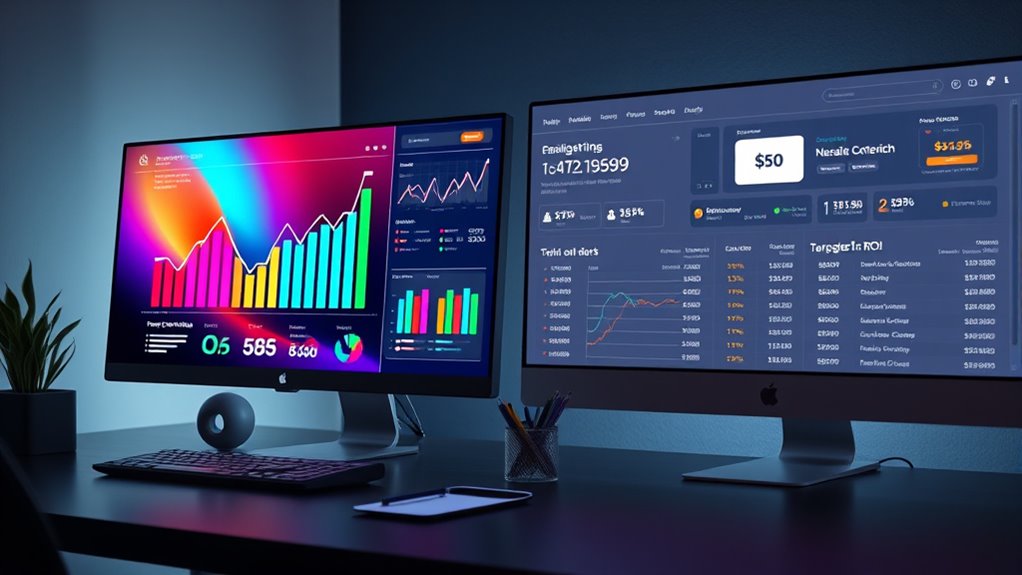When choosing between email marketing and paid ads, consider your budget and goals. Email marketing offers low costs, highly personalized content, and fosters customer loyalty, making it very cost-effective for nurturing existing leads. Paid ads can generate quick traffic with targeted reach but often require ongoing spending. Both strategies have strengths; combining them can maximize your ROI. If you want to explore how to balance these channels effectively, you’ll find helpful insights ahead.
Key Takeaways
- Email marketing offers low ongoing costs with high personalization, boosting customer loyalty and long-term ROI.
- Paid ads require continuous investment but deliver immediate traffic and conversions through precise targeting.
- Combining both strategies enhances overall cost-effectiveness by attracting new leads and nurturing existing customers.
- Personalization in email marketing increases engagement, while targeted paid ads improve relevance and conversion rates.
- The optimal choice depends on budget, goals, and audience, with integrated strategies maximizing ROI.

When it comes to growing your business online, choosing the right marketing strategy can make all the difference. Two popular options are email marketing and paid ads, each with its own strengths in terms of cost-effectiveness and return on investment (ROI). To maximize your results, understanding how these channels leverage personalization strategies and targeting accuracy is vital. Email marketing allows you to craft highly personalized messages that resonate with your audience. By segmenting your email list based on customer behavior, preferences, and purchase history, you can deliver content that feels tailored to each recipient. This level of personalization boosts engagement rates and fosters loyalty, ultimately leading to a higher ROI. Plus, once you’ve built a quality email list, the costs associated with sending emails are relatively low, making it a budget-friendly option for sustained outreach.
Paid ads, on the other hand, excel in targeting accuracy. Platforms like Google Ads or Facebook Ads use sophisticated algorithms to reach specific audiences based on demographics, interests, and online behaviors. This precision means you can quickly target potential customers who are most likely to convert, often producing faster results than email campaigns. However, paid ads typically require ongoing investment, and costs can escalate if you’re not careful with your targeting. Without proper optimization, your ad spend might not translate into proportionate returns, impacting overall cost-effectiveness. But when executed well, paid ads can generate immediate traffic and conversions, providing a strong boost to your ROI.
Both strategies can be highly effective, but their success hinges on how well you implement personalization strategies and targeting accuracy. Email marketing shines when you nurture existing leads through tailored content, encouraging repeat business and customer loyalty at a relatively low cost. Paid ads are better suited for reaching new audiences quickly, especially when you leverage detailed targeting options to refine your audience and improve ad relevance. The key to maximizing ROI is to use both channels complementarily—using paid ads to attract new visitors and email marketing to nurture and convert those visitors into loyal customers. Ultimately, your choice should align with your budget, goals, and the nature of your audience. When you understand the strengths of each and refine your targeting and personalization tactics, you can make smarter decisions that drive better results for your business.
Frequently Asked Questions
How Do Industry-Specific Factors Influence Cost-Effectiveness?
Industry-specific factors like current trends and niche competition directly affect the cost-effectiveness of your marketing strategies. If your industry is highly competitive, paid ads might cost more and deliver lower ROI, whereas email marketing can stand out by targeting engaged audiences cost-efficiently. Understanding these factors helps you allocate your budget wisely, maximizing your return and ensuring your campaigns align with industry dynamics to stay ahead of competitors.
What Are the Long-Term ROI Differences Between the Two Strategies?
You’ll find that email marketing often delivers higher long-term ROI because it builds brand loyalty and boosts customer engagement over time. Paid ads may generate quick results but tend to have diminishing returns without ongoing investment. By nurturing your audience through consistent email communication, you create lasting relationships that translate into sustained revenue, making email marketing more cost-effective for long-term growth compared to paid advertising.
How Do Audience Targeting Capabilities Compare in Depth?
You find that email marketing offers detailed audience targeting through segmentation strategies, allowing you to tailor messages precisely. Platforms like Mailchimp or HubSpot enable in-depth segmentation based on demographics, behaviors, and preferences. Paid advertising platforms like Google Ads or Facebook Ads provide robust targeting capabilities using platform capabilities such as interest targeting, lookalike audiences, and retargeting. Both methods give you strong targeting options, but email allows for more personalized, nuanced segmentation.
What Are the Hidden Costs Associated With Each Method?
You might think email marketing’s only cost is sending emails, but hidden costs lurk in email setup, creating engaging content, and maintaining an updated list. Paid ads seem straightforward, yet they can rack up expenses with ad design, testing, and ongoing optimization. Both methods hide expenses that can surprise you, making your ROI less straightforward. Always budget for these unseen costs to truly gauge each approach’s value.
How Quickly Can Businesses See Results From Each Approach?
You can see results from email automation within days, especially if you have an engaged list, as it quickly nurtures leads. Paid ad metrics, however, may take a week or more to show meaningful data, depending on your campaign setup and audience targeting. Both methods require ongoing optimization, but email delivers faster initial responses, while paid ads provide measurable results and insights over time.
Conclusion
Think of email marketing and paid ads as two tools in your toolbox. I once used email like a steady hammer—consistent and reliable—while paid ads were my quick screwdriver—targeted and powerful. Data shows email boasts a 42:1 ROI, making it a cost-effective choice for long-term growth. When you combine both, you’re building a sturdy, versatile toolkit that drives results—like a craftsman skilled at both nails and screws.
Natali – Editor in Chief (Strategy and Mastery, AI Expert) Natali, our Editor in Chief, is the driving force behind our content’s strategic direction. With a keen eye for detail and a deep understanding of market trends, Natali ensures that our content is top-notch and strategically aligned with our client’s goals. Her expertise in AI helps to seamlessly integrate advanced technology into our marketing strategies, pushing the boundaries of conventional marketing.










